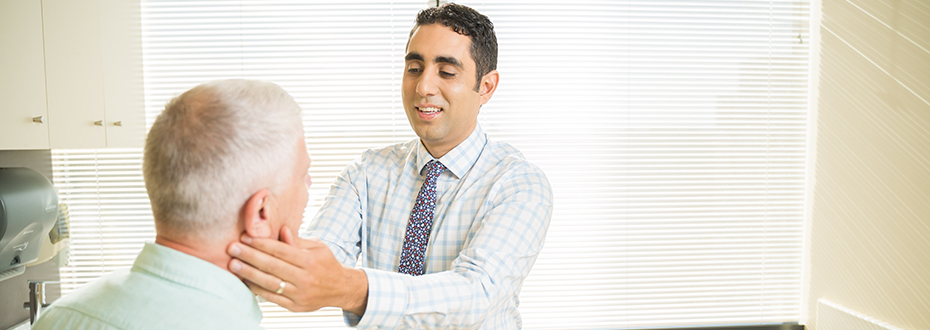Radiation Therapy FAQ

Here are answers to common questions about radiation therapy at the OHSU Knight Cancer Institute.
The first step is to see one of our specialists, a doctor called a radiation oncologist, for a consultation. Your radiation oncologist will work with your primary doctor and other cancer specialists to help oversee your treatment. If radiation therapy is a good option, you and the radiation oncologist will develop a treatment plan.
If your treatment plan calls for external radiation therapy, you will go through a process called simulation. This helps your team figure out the logistics of your treatment. Treatment usually begins one to three weeks after the simulation.
During the simulation, your team determines where to aim the radiation beam and how to position your body for treatments. Your team will use scans to precisely target treatment. They may mark your body with tiny tattoos to guide positioning. You also may receive a custom-made mask or cushion to help you stay in the same position.
In some cases, your team may create 3D images of your tumor. This helps the team contour the target area, allowing the radiation beam to zero in on your cancer and avoid healthy tissue.
At the Knight Cancer Institute, a team of specialists will help you navigate treatment. Your team may include:
Radiation oncologists who use their expert knowledge of radiation therapy to guide your care.
Radiation oncology nurses who help you understand your treatment plan and address any questions or concerns. They also teach you how to manage any radiation-related side effects.
Radiation therapists who administer treatments. The therapist takes you into the treatment room, positions your body and operates the radiation machine.
Radiation physicists who calculate the best dose for you.
Dosimetrists who use sophisticated technology to outline your treatment plan. The dosimetrist works with the radiation oncologist and physicist to ensure the highest quality treatment is delivered.
Scheduling coordinators who set up your consultation, daily appointments and follow-up care. They can also help with any parking or transportation concerns.
You will most likely meet with your radiation oncologist once a week to review your progress and discuss any concerns. A nurse or doctor will always be available to answer your questions between appointments.
You will be in the treatment room alone, but you can communicate with your team through an intercom. If needed, your radiation therapist can stop the machine at any time to address your concerns.
For most types of cancer, radiation therapy lasts five to seven weeks. Radiation is usually given five days a week, Monday through Friday. Each session takes about 45 minutes, with about 10 minutes in the treatment room.
Radiation treatment is painless. Our machines may make some noise, but patients are encouraged to listen to music to counteract it.
Your side effects will vary depending on the area treated. The most common side effects go away a few weeks after treatment. They may include:
- Tiredness: Fatigue is usually noticeable after a few weeks of radiation therapy. You should still be able to do your normal activities, but you may not be able to do them for as long. Toward the end of treatment, you may want to nap in the afternoon and sleep longer at night.
- Loss of appetite: Cancer patients who receive radiation therapy have a higher caloric demand than normal. This means you have to eat more to maintain your weight even as cancer treatment may reduce your appetite. Try to eat many small meals through the day, supplemented with high-calorie nutritional drinks such as Boost or Ensure.
- Sunburn: Your skin may become dry, red or itchy about four weeks into treatment. This is most common for patients who get radiation therapy for breast cancer or head and neck cancer. Some patients find relief by applying alcohol-free aloe vera gel after each treatment.
- Hair loss: You may lose some hair, but only in the area that's being treated. (This is different from chemotherapy, which can cause hair loss on your head.) Hair usually grows back in 3 to 6 months after treatment. If you get a very high dose of radiation, it may come back thinner or not at all.
We have resources to help you cope with the side effects of cancer and cancer treatment.
You should be able to do all your normal activities, though you may not be able to do them for as long. Radiation therapy alone won’t limit your activities, but your cancer diagnosis and other health concerns might.
Radiation is a type of energy that travels in waves. The radiation punches a hole through the DNA inside a cell. Normal cells can repair their DNA, but cancer cells can’t. If the radiation can punch enough holes in a cancer cell’s DNA, the cell stops growing and eventually dies.
Learn more
- Radiation Therapy at the OHSU Knight Cancer Institute
- External Beam Radiation Therapy
- Brachytherapy
- Radiation Therapy: What to Expect, American Society for Radiation Oncology
For patients
- Request an appointment at our Marquam Hill location: 503-494-8756
- Request an appointment at our Beaverton location: 971-262-9400
Visit our For Cancer Patients page to find a cancer doctor and links to diagnoses.
Locations
OHSU Knight Cancer Institute Radiation Medicine, Marquam Hill
Kohler Pavilion, fourth floor
808 S.W. Campus Drive
Portland, OR 97239
OHSU Knight Cancer Institute, Beaverton
15700 S.W. Greystone Court
Beaverton, OR. 97006
Free parking for patients and visitors
Refer a patient
- Refer your patient to OHSU.
- Call 503-494-4567 to seek provider-to-provider advice.
Read more
Learn more about OHSU Knight Cancer Institute treatments: